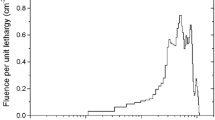Abstract
Sealed radiation sources containing CsCl have a chemical instability created by decay of 137Cs to 137Ba that creates a strong reducing environment inside the source. If exposed to air, strong exothermic reaction could result and may vaporize contents of the source. This study examines chemical equilibria inside sources before and after exposure to air to identify reactions involved and uncertainties due to decay time, temperature, impurity content, and cesium isotopic distribution. The overall goal is to present quantitative understanding that will inform safe handling and dismantlement procedures for sources.




Similar content being viewed by others
References
SN Storch (2006) Characteristics of cesium and strontium source materials from the hanford waste encapsulation and storage facility used for source fabrication at Oak Ridge National Laboratory, ORNL/TM-2005/217, Oak Ridge National Laboratory
Cesium-137: a systems evaluation, Encapsulation to Release at Radiation Sterilizers, Inc. Decatur Georgia (1990) Interim Report of the DOE Type B Investigation, DOE/ORO-914
JM Tingey, MG Plys, GL Tingey (2003) Capsule integrity report for capsule dry storage project. WMP-16939, Fluor Hanford
Sealed source recovery at the university of washington harborview training and research facility results in release of Cesium-137 on May 2, 2019 (2020) Joint Investigative Report, T. Wyka, Cognizant Secretarial Officer for Safety, NNSA & Triad National Security LLC
FactSage Version 8.1. See also: CW Bale et al. (2016) FactSage thermochemical software and databases, 2010–2016, CALPHAD 54:35–53
C Jiang, CR Stanek, NA Marks, KE Sickafus, BP Uberuaga (2009) Predicting from first principles the chemical evolution of crystalline compounds due to radioactive decay: the case of the transformation of CsCl to BaCl. Phys Rev B 79:132110
BP Uberuaga, C Jiang, CR Stanek, KE Sickafus, NA Marks, DJ Carter, AL Rohl (2010) Implications of transmutation on the defect chemistry in crystalline waste forms. Nucl Inst Methods in Phys Res B 268:3261–3264
CF Weber, DG Abrecht (2022) Engineering evaluation of barium buildup in a decayed CsCl sealed source and potential impact for cesium release from a breached source, ORNL/TM-2022/2384, Oak Ridge National Laboratory
E Lamb (1980) Cesium-137 source material for an irradiator, CONF-800964–1. In: presented at the National Symposium on the Use of Cesium-137 to Process Sludge for Further Reduction of Pathogens, Denver, CO
GH Bryan (1989) Cesium chloride compatibility testing program—final report, PNL-7133 (UC-721) Pacific Northwest Laboratory
GH Bryan, GL Tingey, DR Olander (2003) Corrosion report for capsule dry storage, WMP-16937, Fluor Hanford
BT Kenna, FJ Schultz (1983) Characterization of an aged WESF capsule, SAND83–0928, Sandia National Laboratory
RR Jackson (1977) Hanford waste encapsulation: strontium and cesium. Nucl Tech 32:10–15
DJ Sasmor, JD Pierce, GL Tingey, HE Kjarmo, J Tills, DC McKeon (1988) Characterization of two WESF capsules after five years of service, SAND86–2808, Sandia National Laboratory
GL Tingey, EJ Wheelwright, JM Lytle (1984) A review of safety issues that pertain to the use of wesf cesium chloride capsules in an irradiator, PNL-5170 (UC-70), Pacific Northwest Laboratory
HT Fullam (1982) Cesium chloride compatibility testing program annual report—fiscal year 1982, PNL-4556 (UC-70), Pacific Northwest Laboratory
Acknowledgements
This work was sponsored by the US Department of Energy, National Nuclear Security Administration, Office of Radiological Security.
Author information
Authors and Affiliations
Corresponding author
Additional information
Publisher's Note
Springer Nature remains neutral with regard to jurisdictional claims in published maps and institutional affiliations.
Rights and permissions
About this article
Cite this article
Weber, C.F., Abrecht, D.G. Thermodynamic modeling to facilitate safe handling of CsCl sealed sources. J Radioanal Nucl Chem 331, 4905–4911 (2022). https://doi.org/10.1007/s10967-022-08592-8
Received:
Accepted:
Published:
Issue Date:
DOI: https://doi.org/10.1007/s10967-022-08592-8



